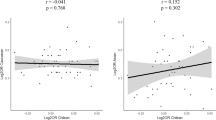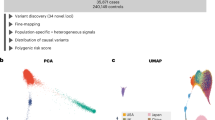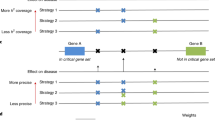Abstract
Genome-wide association studies have enabled the identification of important genetic factors in many trait studies. However, only a fraction of the heritability can be explained by known genetic factors, even in the most common diseases. Genetic loci combinations, or epistatic contributions expressed by combinations of single nucleotide polymorphisms (SNPs), have been argued to be one of the critical factors explaining some of the missing heritability, especially in oligogenic/polygenic diseases. Rheumatoid arthritis (RA) is a complex disease with more than 100 reported SNP associations, as well as various HLA haplotypes and amino acids; however, many associations between RA and inter-chromosomal SNP combinations are unknown. To discover novel associations of epistatic interactions with high odds ratios in RA, we applied the LAMPLINK method, a systematic enumerative procedure for identifying high-order SNP combinations, to a Japanese RA cohort (discovery cohort; 4024 patients with RA and 7731 controls). We validated the identified associations in a different Japanese cohort (validation cohort; 810 RA patients and 6303 controls). In this study, we identified 90 significant genetic associations in the discovery cohort. Among these, 74 (82.2%) associations were replicated in the validation cohort, and eight combinations were inter-chromosomal, all of which comprised rs7765379 or rs35265698 located in the HLA region. These two SNPs exhibited strong correlations with valine at amino acid position 11 in HLA-DRB1 (HLA-DRB1-11-Val). Finally, we discovered that rs9624 showed an association with RA through an epistatic interaction with HLA-DRB1-11-Val. Overall, LAMPLINK showed high reliability for identifying epistatic genetic contributions hidden in complex traits.
This is a preview of subscription content, access via your institution
Access options
Subscribe to this journal
Receive 12 print issues and online access
$259.00 per year
only $21.58 per issue
Buy this article
- Purchase on Springer Link
- Instant access to full article PDF
Prices may be subject to local taxes which are calculated during checkout



Similar content being viewed by others
References
Tam V, Patel N, Turcotte M, Bosse Y, Pare G, Meyre D. Benefits and limitations of genome-wide association studies. Nat Rev Genet. 2019;20:467–84.
Boyle EA, Li YI, Pritchard JK. An expanded view of complex traits: from polygenic to omnigenic. Cell. 2017;169:1177–86.
Bayat A, Hosking B, Jain Y, Hosking C, Kodikara M, Reti D, et al. Fast and accurate exhaustive higher-order epistasis search with BitEpi. Sci Rep. 2021;11:15923.
Wan X, Yang C, Yang Q, Xue H, Fan X, Tang NLS, et al. BOOST: A fast approach to detecting gene-gene interactions in genome-wide case-control studies. Am J Hum Genet. 2010;87:325–40.
Ma L, Brautbar A, Boerwinkle E, Sing CF, Clark AG, Keinan A. Knowledge-driven analysis identifies a gene–gene interaction affecting high-density lipoprotein cholesterol levels in multi-ethnic populations. PLOS Genet. 2012;8:e1002714.
Terada A, Okada-Hatakeyama M, Tsuda K, Sese J. Statistical significance of combinatorial regulations. Proc Natl Acad Sci USA. 2013;110:12996–3001.
Terada A, Yamada R, Tsuda K, Sese J. LAMPLINK: detection of statistically significant SNP combinations from GWAS data. Bioinformatics. 2016;32:3513.
Minato S, Uno T, Tsuda K, Terada A, Sese J. A fast method of statistical assessment for combinatorial hypotheses based on frequent itemset enumeration. Machine Learning and Knowledge Discovery in Databases. 2014;8725:422–36.
Okada Y, Wu D, Trynka G, Raj T, Terao C, Ikari K, et al. Genetics of rheumatoid arthritis contributes to biology and drug discovery. Nature. 2014;506:376–81.
Raychaudhuri S, Sandor C, Stahl EA, Freudenberg J, Lee HS, Jia X, et al. Five amino acids in three HLA proteins explain most of the association between MHC and seropositive rheumatoid arthritis. Nat Genet. 2012;44:291–6.
Qiao B, Huang CH, Cong L, Xie J, Lo SH, Zheng T. Genome-wide gene-based analysis of rheumatoid arthritis-associated interaction with PTPN22 and HLA-DRB1. BMC Proc. 2009;3:S132.
Genin E, Coustet B, Allanore Y, Ito I, Teruel M, Constantin A, et al. Epistatic interaction between BANK1 and BLK in rheumatoid arthritis: results from a large trans-ethnic meta-analysis. PLoS One. 2013;8:e61044.
Diaz-Gallo LM, Ramskold D, Shchetynsky K, Folkersen L, Chemin K, Brynedal B, et al. Systematic approach demonstrates enrichment of multiple interactions between non-HLA risk variants and HLA-DRB1 risk alleles in rheumatoid arthritis. Ann Rheum Dis. 2018;77:1454–62.
Stahl EA, Wegmann D, Trynka G, Gutierrez-Achury J, Do R, Voight BF, et al. Bayesian inference analyses of the polygenic architecture of rheumatoid arthritis. Nat Genet. 2012;44:483–9.
Nagai A, Hirata M, Kamatani Y, Muto K, Matsuda K, Kiyohara Y, et al. Overview of the BioBank Japan Project: Study design and profile. J Epidemiol. 2017;27:S2–8.
Setoh K, Matsuda F, Cohort Profile: The Nagahama Prospective Genome Cohort for Comprehensive Human Bioscience (The Nagahama Study). In: Yano M, Matsuda F, Sakuntabhai A, Hirota S, editors. Socio-Life Science and the COVID-19 Outbreak: Public Health and Public Policy [Internet]. Singapore: Springer Singapore; 2022. p. 127–43. Available from: https://doi.org/10.1007/978-981-16-5727-6_7.
Purcell S, Neale B, Todd-Brown K, Thomas L, Ferreira MA, Bender D, et al. PLINK: a tool set for whole-genome association and population-based linkage analyses. Am J Hum Genet. 2007;81:559–75.
Delaneau O, Marchini J, Zagury JF. A linear complexity phasing method for thousands of genomes. Nat Methods. 2011;9:179–81.
Das S, Forer L, Schonherr S, Sidore C, Locke AE, Kwong A, et al. Next-generation genotype imputation service and methods. Nat Genet. 2016;48:1284–7.
Gao X, Starmer J, Martin ER. A multiple testing correction method for genetic association studies using correlated single nucleotide polymorphisms. Genet Epidemiol. 2008;32:361–9.
Kendall MG. A new measure of rank correlation. Biometrika. 1938;30:81–93.
Viechtbauer W. Conducting meta-analyses in R with the metafor package. J Stat Softw. 2010;36:1–48.
Lex A, Gehlenborg N, Strobelt H, Vuillemot R, Pfister H. UpSet: visualization of intersecting sets. IEEE Trans Vis Comput Graph. 2014;20:1983–92.
Buniello A, MacArthur JAL, Cerezo M, Harris LW, Hayhurst J, Malangone C, et al. The NHGRI-EBI GWAS Catalog of published genome-wide association studies, targeted arrays and summary statistics 2019. Nucleic Acids Res. 2019;47:D1005–12.
Naito T, Suzuki K, Hirata J, Kamatani Y, Matsuda K, Toda T, et al. A deep learning method for HLA imputation and trans-ethnic MHC fine-mapping of type 1 diabetes. Nat Commun. 2021;12:1639.
Okada Y, Kim K, Han B, Pillai NE, Ong RT, Saw WY, et al. Risk for ACPA-positive rheumatoid arthritis is driven by shared HLA amino acid polymorphisms in Asian and European populations. Hum Mol Genet. 2014;23:6916–26.
Pillai NE, Okada Y, Saw WY, Ong RTH, Wang X, Tantoso E, et al. Predicting HLA alleles from high-resolution SNP data in three Southeast Asian populations. Hum Mol Genet. 2014;23:4443–51.
Mitsuhashi N, Toyo-oka L, Katayama T, Kawashima M, Kawashima S, Miyazaki K, et al. TogoVar: A comprehensive Japanese genetic variation database. Hum Genome Var. 2022;9:1–9.
Robinson J, Soormally AR, Hayhurst JD, Marsh SGE. The IPD-IMGT/HLA Database – New developments in reporting HLA variation. Hum Immunol. 2016;77:233–7.
Kawaguchi S, Matsuda F. High-definition genomic analysis of HLA genes via comprehensive HLA allele genotyping. Methods Mol Biol. 2020;2131:31–8.
Freudenberg J, Lee HS, Han BG, Shin HD, Kang YM, Sung YK, et al. Genome-wide association study of rheumatoid arthritis in Koreans: population-specific loci as well as overlap with European susceptibility loci. Arthritis Rheum. 2011;63:884–93.
Lefranc MP, Duprat E, Kaas Q, Tranne M, Thiriot A, Lefranc G. IMGT unique numbering for MHC groove G-DOMAIN and MHC superfamily (MhcSF) G-LIKE-DOMAIN. Dev Comp Immunol. 2005;29:917–38.
Holoshitz J, Liu Y, Fu J, Joseph J, Ling S, Colletta A, et al. An HLA-DRB1–coded signal transduction ligand facilitates inflammatory arthritis: a new mechanism of autoimmunity. J Immunol. 2013;190:48–57.
van Schaardenburg D, Nielen MMJ, Lems WF, Twisk JWR, Reesink HW, van de Stadt RJ, et al. Bone metabolism is altered in preclinical rheumatoid arthritis. Ann Rheum Dis. 2011;70:1173–4.
Kang K, Nam S, Kim B, Lim JH, Yang Y, Lee MS, et al. Inhibition of osteoclast differentiation by overexpression of NDRG2 in monocytes. Biochem Biophys Res Commun. 2015;468:611–6.
Acknowledgements
This work was supported by JST, CREST Grant Number JPMJCR1502 and JST, AIP Acceleration Research JPMJCR21U2, Japan. We express our gratitude to all the participants in the BioBank Japan Project and Nagahama Study. M.S. was supported by the Kyoto-McGill International Collaborative Program in Genomic Medicine.
Author information
Authors and Affiliations
Corresponding authors
Ethics declarations
Competing interests
The authors declare no competing interests.
Additional information
Publisher’s note Springer Nature remains neutral with regard to jurisdictional claims in published maps and institutional affiliations.
Supplementary information
Rights and permissions
Springer Nature or its licensor (e.g. a society or other partner) holds exclusive rights to this article under a publishing agreement with the author(s) or other rightsholder(s); author self-archiving of the accepted manuscript version of this article is solely governed by the terms of such publishing agreement and applicable law.
About this article
Cite this article
Shibata, M., Terada, A., Kawaguchi, T. et al. Identification of epistatic SNP combinations in rheumatoid arthritis using LAMPLINK and Japanese cohorts. J Hum Genet (2024). https://doi.org/10.1038/s10038-024-01269-y
Received:
Revised:
Accepted:
Published:
DOI: https://doi.org/10.1038/s10038-024-01269-y



